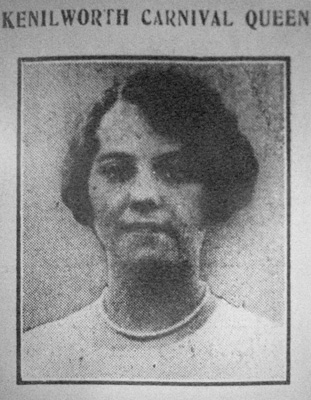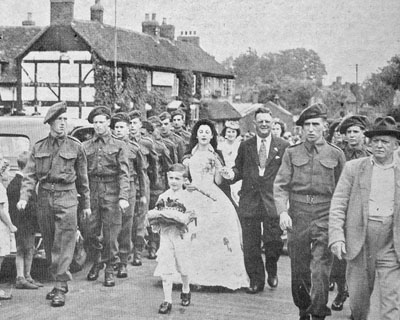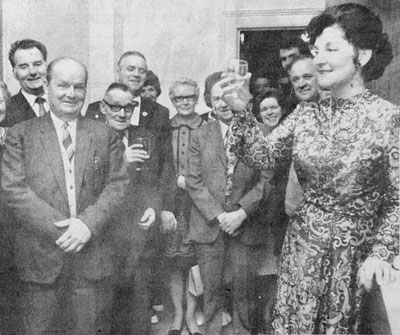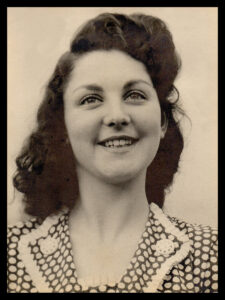Origins of Kenilworth’s Carnival
(Published the the KWN June 2008)

In all its 70-year history, the Kenilworth Advertiser only once published a photograph of a Kenilworth person; it was in 1929 of Miss A M Beck the Kenilworth Carnival Queen, describing her as “a most winsome figure.”
Although Kenilworth’s first carnival for the raising of charitable funds is recognised as being in 1926, it is really a continuation of a fund raising event that goes back another 40 years.
The Hospital Saturday movement in Leamington raised funds for treating patients at Warneford hospital, the annual expenditure of which amounted to £15,000. In 1886, the movement was extended to Kenilworth because the cost of treating patients from here was about double the money raised from town residents by other means. There were four collecting points in town in this first year of the scheme and about £40 was donated to the hospital.
In following years the scheme expanded. Businesses started their own collections, the Tannery regularly topped the charts as it had the largest workforce, but the brickyards, fellmongers and builders also made good contributions. Public houses held collections and The White Lion even held its own events, including flower shows and fruit sales, to boost its Warneford donations.
The Hospital Saturday movement continued throughout the Great War and in the 1920s was as popular as ever; 1921 saw a show put on at the Parochial Hall to boost the funds.
Then, in the summer of 1925, there were not one but two parades in Kenilworth. In June, the council school paraded to raise money for sports equipment. Some of the children were on floats, wagons had been loaned by businesses such as Stickley coal merchants and Street’s the fellmongers. A few weeks later there was a second parade by over 400 children, some in fancy dress, of the members of the Working Men’s Club in association with their annual party. Though not directly linked at the time, these events seem to be inspirational towards the establishing of a proper carnival the following year.
In 1926, Hospital Saturday ended and was replaced by another scheme, but in Kenilworth fund-raising for Warneford was as strong as ever. Instigated by a Mr T Tipson and a Mrs Kimber, a ‘festival’ was arranged for the collection of funds on the 17th July. The main organisers were the committee of the Working Men’s Club, who of course had experience of their own parades. The result was a procession through the town, starting in Priory Road, of over 300 people dressed up in costumes and outfits, some riding in cars, some on horses, but most on foot. In a direct link to the previous year, the children of the Working Men’s Club families joined in, adding over 400 to the numbers. In the evening there was dancing to a band in the Abbey Fields. More than £70 was raised. The most remarkable fact about the event is that the idea originated just three weeks before the day!
The following year, the event was extended with the Kenilworth Hospital Carnival secretary, T Tipson, gaining permission to use the Abbey Fields for a fair on carnival day. Steam engines and merry-go-rounds were not allowed, but still over 5,000 attended. The various carnival prizes were presented in a ceremony at the cinema in Station Road. Although the Hospital Saturday movement no longer existed, inns and businesses continued to contribute their donations as before.
In connection with the event in 1928, cars were allowed to park in the Abbey Fields for the first time and the attendance at the fair exceeded the population of the town! A Carnival Queen had been chosen, controversially for some she was a Coventry girl – the following year a Kenilworth girl became the first home-town queen, the above pictured Miss Beck. Other attractions continued to be held, such as pony racing at Crew Farm, a swimming meeting at the pool, a dance, open-air service etc., all helping to establish the carnival as the biggest annual event in the town.
Today of course, it is not the Warneford Hospital that benefits from the fund raising, and it takes a little longer than three weeks to organise, but as you make your donations at Kenilworth’s carnival, remember you are continuing a tradition started by generous townsfolk over 122 years ago.
The Carnival is revived, post war

It was in late 1972 that the official opening of the British Legion Club at the former Police Station in Albion Street took place. It had been three years since the members first set foot in the building, initially using just the part that had been the Police Clubroom, whilst meetings and get-togethers continued to be held at the Virgins & Castle in High Street.
But, as reported in 1972, the move to the Police Station really started in the immediate post-war years.
The Legion of course had become a focal point for returning servicemen, but the club had no premises of its own, and had no funds to finance one. Kenilworth’s carnival had obviously been suspended during the years of conflict, and no parade took place in 1946, but in 1947 it was revived with the Legion members being the driving force behind it; the proceeds from the carnival were to be allocated to fund a permanent clubhouse for themselves.
The Carnival Queen chosen that year was 19-year-old Patsy Wheeler and the photograph shows her being escorted by servicemen to her coronation on Castle Green. She was described as “The leading lady at a time when girls looked like girls”.
The carnival raised about £1,200 for ‘The Legion’. An account was opened, but the money remained untouched for the best part of a quarter of a century, until it was used to finance the refurbishment of the police station. In 1972, there was only one person who the members wished to perform the official opening of their club – their Carnival Queen of 25 years before, and Mrs Patsy Bell as she had become, was delighted to oblige. Despite the passage of time, Patsy still captured the universal admiration of them all.

Patsy Bell, 1928 – 2020

In this Carnival week, it is with much sadness that I have been asked to announce that Kenilworth’s 1947 Carnival Queen, Patsy Bell, Patsy Wheeler as was, has died at the age of 92.
This first post-war carnival, 73 years ago this Sunday, 28th June, without doubt the finest the town has ever staged, was held at a time of great hope, optimism and enthusiasm for an improved and more joyous future, and 19-year-old Patsy’s effervescent personality fitted the occasion perfectly.
She was chosen from an entry of 16; ‘None could have been more popular than Miss Patsy Wheeler’.
Patsy attended as many Carnival events as possible…….the swimming gala, motor cycle football, midnight soiree at the Alexandra Cinema, the Carnival Ball, and the incredible Military Tattoo at Kenilworth Cricket Ground featuring no fewer than 11 units from the services.
Remarkably, there is a colour film of the 1947 carnival, of Patsy as Queen on the day, giving prizes at the swimming gala, enjoying herself at the fair, at the tattoo, and in virtually every shot she is talking and chatting and laughing, enjoying the company of those around her. From knowing her in her later days, I think I can say that never changed.
Patsy recalled, ‘I remember being Queen as a very busy and happy time; there were so many events. The Carnival Ball was like magic with so many people packed inside with dancing, cabaret and a buffet. So much work and effort was put in by so many folk’.
A later Carnival Committee Chairman was to recall; ‘She was a pioneer; it was the first carnival for 8 years, so soon after the war when everything had been drab and cheerless. Townsfolk really took her to their hearts, and people still reminisce about her’.
The Carnival was for Kenilworth’s British Legion funds, hoping for a new headquarters after The Globe was destroyed in 1940. It was not until 1972 that the Legion finally found a new home in Albion Street; the refit was paid for by the 25-year-old carnival proceeds, and when it opened, the ceremony could of course only be performed by their still-popular Queen.
‘Her’ Carnival Ball was held in the Abbey Hotel Ballroom, and Patsy told me of a night in that same ballroom, a couple of years previously, when the Marx brothers were staying at the hotel. She spent several hours in the solo company of Chico, playing duets on the ballroom piano and singing and dancing; she arrived home at gone 3 in the morning.
On one occasion Patsy invited me round by phone; I explained that I would have to change first as I was only wearing shorts; her answer was an excited, ‘Oh Wacko!! Come as you are!!’
She was 85 at the time.
The Patsy I knew in recent years, was still very recognisable as the popular, bubbly teenager in the carnival film.
Such fond memories of such a delightful lady.
Farewell Patsy; I can’t imagine anyone you ever knew, could ever forget you.
(With sincere condolences to Jack, Patsy’s husband, who asked me to write this small tribute to his wife)
A full account of the origins and first 25 years of the carnival, complete with photographs of Queens on horse-drawn floats, is included in my book Kenilworth People & Places, Volume 2
More Kenilworth Carnival articles on this website:
Kenilworth’s ‘Lost’ Wartime Carnivals
Kenilworth’s Forgotten Carnival Queen
Carnival Programmes 1936 – 1975
Carnival posters and tickets, 1962 -1967
How many carnivals has there been?